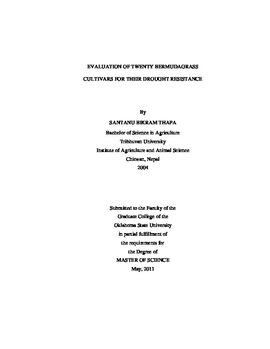| dc.contributor.author | Thapa, Santanu Bikram | |
| dc.date.accessioned | 2014-04-15T22:32:29Z | |
| dc.date.available | 2014-04-15T22:32:29Z | |
| dc.date.issued | 2011-05-01 | |
| dc.identifier.uri | https://hdl.handle.net/11244/9594 | |
| dc.description.abstract | Twenty cultivars were evaluated for visual quality, leaf firing resistance and percent live green cover during exposure to soil moisture deficit as well as during a recovery period. The experiment was replicated three times. Celebration and Premier were selected as standards of comparison in this research. Visual quality (TQ) as well as leaf firing (LF) were evaluated using a 1-9 scale where 9 = excellent quality and no leaf firing. Green cover (LC) was visually estimated from 0 to 100 % where 100 = the entire surface canopy is green. In Experiment II and III percent volumetric soil moisture content was measured at an average 5, 10, 38 and 71 cm depths using a time domain reflectometry (TDR) probe. Air temperature was measured at the turfgrass canopy level, 30.5 cm above and at 10.2 cm below the wooden deck level outside of the growth tubes. Relative humidity was measured at 30.5 cm above the canopy with an electrical resistance type sensor. Photosynthetically Active Radiation (PAR) and incoming solar radiation were measured by silicon diode type sensors at the surface of the canopy. The visual parameters: TQ, LF and LC were strongly positively correlated in all experiments during drydown and recovery cycles. Drought resistance as measured by LC varied greatly among the twenty bermudagrasses in each experiment. In general, Celebration showed the highest resistance to drought by resisting LF and loss of LC during drydown and recovering faster after the drought. Premier showed lower drought resistance as indicated by more rapid LF and earlier loss of LC. TifGrand performed nearly as well as Celebration in drought while Latitude 36 had LF and LC performance similar to Premier. Generally, Celebration, TifGrand and other cultivars with higher drought resistance had improved moisture extraction capacity at deeper soil depths. Cultivars with earlier LF and loss of LC had higher levels of moisture remaining deep in the soil profile during the drought. TifGrand may serve as a bermudagrass having improved drought tolerance if additional standards are needed in future drought studies. | |
| dc.format | application/pdf | |
| dc.language | en_US | |
| dc.publisher | Oklahoma State University | |
| dc.rights | Copyright is held by the author who has granted the Oklahoma State University Library the non-exclusive right to share this material in its institutional repository. Contact Digital Library Services at lib-dls@okstate.edu or 405-744-9161 for the permission policy on the use, reproduction or distribution of this material. | |
| dc.title | Evaluation of Twenty Bermudagrass Cultivars for Their Drought Resistance | |
| dc.type | text | |
| osu.filename | Thapa_okstate_0664M_11453.pdf | |
| osu.college | Agricultural Sciences and Natural Resources | |
| osu.accesstype | Open Access | |
| dc.description.department | Horticulture and Landscape Architecture Department | |
| dc.type.genre | Thesis | |
